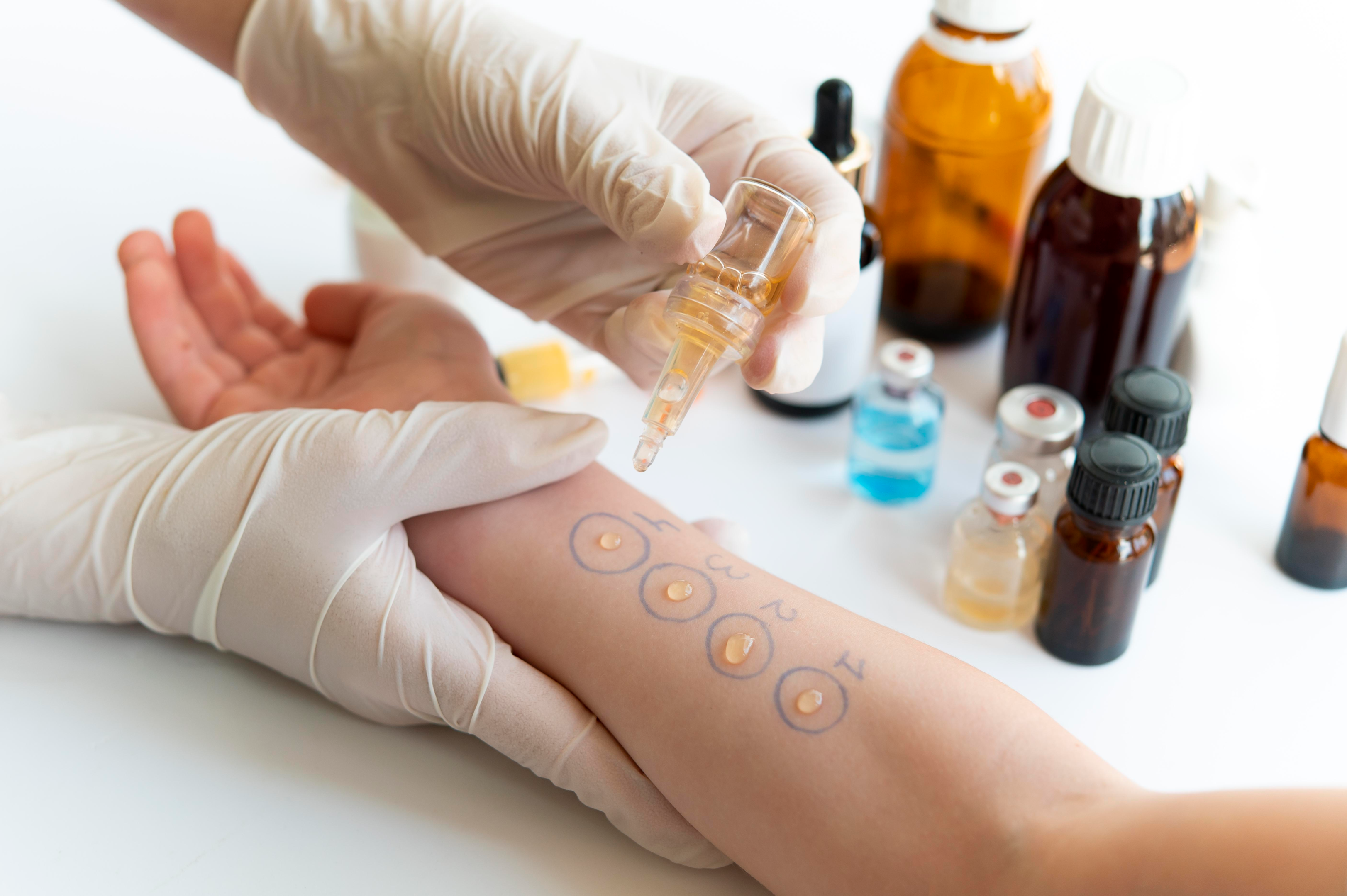What is a dog allergy test?


Everything you need to know about testing for a dog allergy.
Pets dogs are very common in the UK. According to an estimate, there are 12.5 million pet dogs in the UK, and according to a recent survey, 34% of UK households have at least one pet dog. The percentage has increased dramatically in recent years. These statistics make the country second in Europe regarding pet dog ownership.
But, dog ownership is not free from serious health issues. It can cause various problems, including allergic reactions. The most common allergen that dogs produce is dander, the flakes of skin present in the fur. Poor grooming practices and skin infections can cause the production of more flakes.
This dander can reach everywhere, even at places where the dog has never gone and can become a serious source of worry. So, what should you do? How the dog allergy develops, and what is the clinical picture of the issue? How can this issue be diagnosed, treated and prevented? Keep reading for answers.
As mentioned earlier, s dog's body sheds dander, the primary allergen. The longer hairs are more likely to have dander than the short hairs. Moreover, the strands can trap various other allergens, e.g., mould spores, dust, insect proteins, pollen etc. That's why such issues are often reported by the people who keep long-haired breeds of pet dogs.
However, it is more complex, and various factors control the amount of dander shed by the dog, and it has been noted that two dogs of the same breed can shed the same amount of dander and vice versa. In contrast to popular perception, allergic reactions to dog hairs are rare.

The other possible allergens of the dog could include urine and saliva. But, how can pet dander cause an allergic reaction? Some people have an overactive immune system, identifying these everyday things as foreign agents and reacting to them, causing severe allergy symptoms. Anything you will experience after that is just an attempt by the body to get rid of this allergen.
Any allergic reaction will leave many observable signs and symptoms. The typical issues experienced during a dog allergy are respiratory. You can experience the following dog allergy symptoms;
Sneezing
Itchy skin
Stuffy, itchy and runny nose,
Itchy and red eyes
Wheezing and coughing
Some skin reactions can also occur
Occasional hives on chest and feet and any other body parts
The symptoms can be particularly severe in people already battling any allergic reactions, e.g., asthma, food allergies etc.
To learn more about Allergies, read our comprehensive guide that covers: Allergies:, Types, Causes, Symptoms, Diagnosis, and Treatment options.
If you are looking for treatments for hay fever or general allergens, then visit our extensive page with allergy and hayfever medication and tablets.
The symptoms of all allergic reactions can be very similar, and you need to know if the particular symptoms are due to a dog or not. For this purpose, the results of blood and intradermal skin testing are correlated with the clinical signs. Two types of tests are available;
The pathogenesis of dog allergy is due to the allergen-specific immunoglobulins (IgE), which are responsible for most clinical signs. The blood allergy tests for allergies are designed to detect these antibodies in the blood. The reagents in these kits react with the antibodies to give a detectable signal.
In the intradermal skin test, a small amount of known allergen is injected into the skin to check if the allergic reaction occurs. Various allergens are injected, and the allergen causing the reaction is responsible for the clinical signs.

Allergy testing is also recommended because the cause of symptoms often comes out to be mould or pollen allergy, and the dog's coat serves as a career for these allergens. Nevertheless, the dog allergy test doesn't always provide guaranteed results, and the doctor may ask you to live without a dog for some days to see any improvements in the symptoms.
For allergy testing, we have various products available for you. Our Allergy Testing kit is one of the most comprehensive test kits available. It can detect more than 99 different allergens and provide results within two days. Click here to know more and place your order.
Our Food Intolerance Test can help you to roll out food allergies as the cause of symptoms. It is a blood test and needs the blood from a single finger prick and provides results within 2 days. Click here to place your order.
Once the cause is diagnosed, the treatment is relatively straightforward. The treatment protocol is the same for all allergic reactions. The treatments are done to suppress the overactive immune system. The standard treatment options are;
A histamine is a chemical mediator released during allergic reactions and is responsible for most clinical signs. The antihistamine drugs, e.g., loratadine, fexofenadine, diphenhydramine, cetirizine etc., block this mediator and suppress the clinical signs.

Most of these drugs are available on prescription, but some, e.g., loratadine, are available over the counter at pharmacies. They are available in tablet forms, but some are also in the form of nasal sprays. You can buy several antihistamines from Welzo pharmacy. Click here to view our products.
The corticosteroids suppress inflammation and calm down an overactive immune system. They are often used as the first-line treatment for allergies and are also available in the form of nasal sprays. Examples are fluticasone (Flonase, a nasal spray), Budesonide (Rhinocort) etc. They are also available both on prescription and over the counter.
You can buy several corticosteroids from Welzo pharmacy. Click here to view our products.
One of the most critical issues faced during the allergic reaction is nasal congestion causing various respiratory issues. The decongestants relieve this issue. The typical examples are, Allegra-D and Sudafed.
The allergy shots contain small amounts of allergens. When injected into the body, these shots will cause just enough allergic reactions to stimulate the immune system without causing a severe allergic reaction. Over a long period of time, the body will become accustomed to and will not respond to these allergens.
This form of treatment is known as immunotherapy. These shots may only work for some, and you may need a complete course to work. Consult the doctor about its pros and cons.
Read more: What are allergy eye drops?
The best way to avoid allergic reactions is to sort out the causative allergen and prevent exposure. Here are some lines of action for allergic patients.
It might be difficult for you if you are a dog lover. But, you have to take this stern step if you want to avoid dog allergies. If some other family member has a pet dog, ensure that the dog doesn't enter your bedroom. Although dog dander can travel in the air, a closed door can help.
If you have to keep the dog for other reasons, e.g., security, etc., try to keep the dog outside the house as much as possible or at least establish some dog-free areas in your home. If, however, contact with the dogs is unavoidable, consult the veterinary dermatologists to treat the skin infections of your dog that are causing the dander.
Modern houses are sometimes installed with a central cooling and heating system. However, this system can pull the outside dander into all rooms. A central air cleaner system with adequate filters at the air inlets can help reduce allergens.

Pet dander is always airborne and can get everywhere. So, you need a thorough plan for the house cleaning involving sweeping and mopping the floors, cleaning the furniture and all room accessories, cleaning the rugs, vacuuming the carpets, etc. Regular filters in vacuum cleaners don't remove the dander and circulate them into the air, so using a HEPA filter can be helpful.
Consult the engineer before home construction to provide you with a design that easily removes dust and other allergens quickly. It involves strategically placing vents and exhaust fans to ensure lower dust and dander in the living rooms and bedrooms. On your part, reduce the dust and pollen-catching items in your house.
You may want to be cautious about a visitor who owns a pet dog and who visits your home. Such a guest can harbour dander on the luggage and clothing, which can cause an allergic response. Some social factors can limit your options here, and you should design your safety measures to reduce this danger.
If you have a deep love for your pet, try to avoid being too close to them, e.g., don't hug, kiss or touch the dog. Regularly groom your pet and identify and treat any possible skin infection (e.g., atopic dermatitis) that can cause high dander production.
All these options will reduce the risk of future attacks. However, in case of an acute attack, you must regularly take the medicines for fast recovery. Consult the doctor about the preventive drugs which you will use immediately after coming into contact with any dog.
Read more: How do allergy tablets work?
Experts are still determining if regularly bathing your dog can do any benefit. However, some do agree that doing so will lower the level of airborne dander. You need to try for yourself and see what happens. You can also consult someone with a similar issue to see if there is any improvement.
Some studies have found positive results. An earlier study published in the Journal of Allergy and Clinical Immunology in 1999 noted that regular washing reduces the allergen levels in dogs. However, it was pointed out that twice daily showering was required to achieve any results.
A dog allergy is experienced by many pet dog owners and can have several clinical presentations. They range from mild irritation and sneezing to more severe and life-threatening issues, e.g., asthma. Dog dander has been identified to be the main culprit in the majority of the cases.
Both blood and skin tests are available for the diagnosis of the condition. Similarly, there are also many treatment options. The best thing to do is to lower your exposure to dogs and dog dander. Since dogs are present everywhere, it may be difficult for you. However, you can use the techniques mentioned above for some benefits.

If these alone are not working, you may need to resort to more severe and drastic measures, e.g., leaving the dog ownership, which may be challenging for you. If, however, the exposure to the dog dander is secondary, it means some other person in your vicinity, e.g., a family member, owns the pet dog, you should consult the doctor for an emergency treatment which you will use in case of any accidental encounter with the dog.
Don't hesitate to consult with health professionals in case of any issues. At Welzo, our team of health professionals is available for your guidance. Click here for consultation.










Plus get the inside scoop on our latest content and updates in our monthly newsletter.